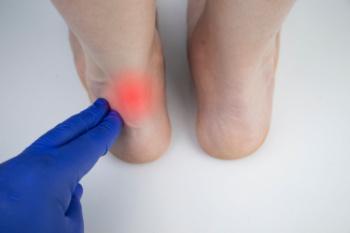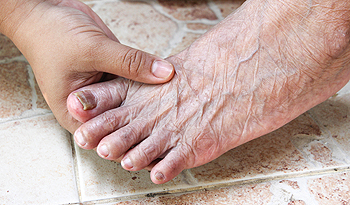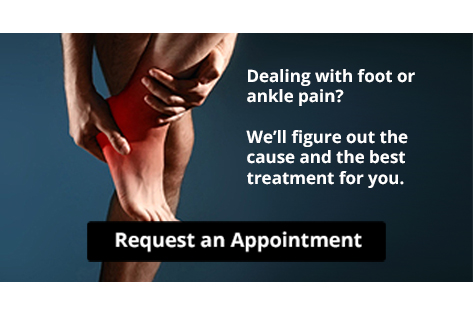Items filtered by date: September 2024
Common Foot Issues in the Elderly

Foot problems are common among the elderly population and can lead to pain, discomfort, and an increased risk of falls. Conditions like achy heels often result from plantar fasciitis or heel spurs, causing stabbing pain that worsens with movement. Corns and calluses develop due to pressure and friction, making walking painful. Bunions, a bony bump at the base of the big toe, can distort foot shape and hinder balance. Hammertoes, where toes curl abnormally, can also limit mobility and cause pressure points. Toenail fungus, often overlooked, can thicken nails and make them difficult to trim, leading to infection and discomfort. Together, these issues not only impact daily activities but also increase the likelihood of falls, making regular foot care essential for seniors to maintain mobility and reduce their risk of injury. Wearing proper footwear and regular checkups with a podiatrist can help manage these conditions. If you are elderly and have any uncomfortable foot condition, it is suggested that you schedule regular appointments with a podiatrist for help in their management.
Proper foot care is something many older adults forget to consider. If you have any concerns about your feet and ankles, contact Darline Kulhan, DPM from Scarsdale Foot Specialists PC. Our doctor can provide the care you need to keep you pain-free and on your feet.
The Elderly and Their Feet
As we age we start to notice many changes in our body, but the elder population may not notice them right away. Medical conditions may prevent the elderly to take notice of their foot health right away. Poor vision is a lead contributor to not taking action for the elderly.
Common Conditions
- Neuropathy – can reduce feeling in the feet and can hide many life-threatening medical conditions.
- Reduced flexibility – prevents the ability of proper toenail trimming, and foot cleaning. If left untreated, it may lead to further medical issues.
- Foot sores – amongst the older population can be serious before they are discovered. Some of the problematic conditions they may face are:
- Gouging toenails affecting nearby toe
- Shoes that don’t fit properly
- Pressure sores
- Loss of circulation in legs & feet
- Edema & swelling of feet and ankles
Susceptible Infections
Diabetes and poor circulation can cause general loss of sensitivity over the years, turning a simple cut into a serious issue.
If you have any questions please feel free to contact our office located in Scarsdale, NY . We offer the newest diagnostic and treatment technologies for all your foot and ankle needs.
Achilles Tendon Injuries in Athletes

Achilles tendon injuries are common among athletes, especially those involved in sports that require running, jumping, or sudden changes in direction, like basketball, soccer, pickleball, or tennis. The Achilles tendon, the largest tendon in the body, connects the calf muscles to the heel bone and plays an important role in walking, running, and jumping. Injuries can range from mild strains to complete tears, often caused by overuse, improper training techniques, or sudden increases in activity intensity. Symptoms usually include sharp pain, stiffness, and swelling near the heel. A ruptured Achilles tendon may be accompanied by a sudden pop and an inability to push off the foot. Treatment depends on the severity and can range from rest to surgery for more serious injuries. Proper conditioning, stretching, and wearing appropriate footwear can help prevent Achilles tendon injuries in athletes. If you are an athlete who has sustained an Achilles tendon injury, it is suggested that you schedule an appointment with a podiatrist for care.
Achilles tendon injuries need immediate attention to avoid future complications. If you have any concerns, contact Darline Kulhan, DPM of Scarsdale Foot Specialists PC. Our doctor can provide the care you need to keep you pain-free and on your feet.
What Is the Achilles Tendon?
The Achilles tendon is a tendon that connects the lower leg muscles and calf to the heel of the foot. It is the strongest tendon in the human body and is essential for making movement possible. Because this tendon is such an integral part of the body, any injuries to it can create immense difficulties and should immediately be presented to a doctor.
What Are the Symptoms of an Achilles Tendon Injury?
There are various types of injuries that can affect the Achilles tendon. The two most common injuries are Achilles tendinitis and ruptures of the tendon.
Achilles Tendinitis Symptoms
- Inflammation
- Dull to severe pain
- Increased blood flow to the tendon
- Thickening of the tendon
Rupture Symptoms
- Extreme pain and swelling in the foot
- Total immobility
Treatment and Prevention
Achilles tendon injuries are diagnosed by a thorough physical evaluation, which can include an MRI. Treatment involves rest, physical therapy, and in some cases, surgery. However, various preventative measures can be taken to avoid these injuries, such as:
- Thorough stretching of the tendon before and after exercise
- Strengthening exercises like calf raises, squats, leg curls, leg extensions, leg raises, lunges, and leg presses
If you have any questions please feel free to contact our office located in Scarsdale, NY . We offer the newest diagnostic tools and technology to treat your foot and ankle needs.
We Can Treat Your Foot or Ankle Pain
Toenail Fungus in the Elderly Population

Toenail fungus is a common issue among the elderly, often overlooked but significant in maintaining overall foot health. As people age, their nails become thicker, more brittle, and slower to grow, creating an ideal environment for fungal infections. This condition, known as onychomycosis, typically begins as a white or yellow spot under the toenail and can progress to cause discoloration, thickening, and crumbling edges. For elderly people, toenail fungus can be particularly troublesome due to weakened immune systems and difficulty in maintaining foot hygiene. Regular inspection of the feet, keeping nails trimmed, and wearing breathable footwear can help to prevent infections. Treatment often involves topical antifungal creams or, in more severe cases, oral medication. If you are elderly or helping to take care of an elderly person, it is suggested that you schedule an appointment with a podiatrist if symptoms of toenail fungus appear.
If left untreated, toenail fungus may spread to other toenails, skin, or even fingernails. If you suspect you have toenail fungus it is important to seek treatment right away. For more information about treatment, contact Darline Kulhan, DPM of Scarsdale Foot Specialists PC. Our doctor can provide the care you need to keep you pain-free and on your feet.
Symptoms
- Warped or oddly shaped nails
- Yellowish nails
- Loose/separated nail
- Buildup of bits and pieces of nail fragments under the nail
- Brittle, broken, thickened nail
Treatment
If self-care strategies and over-the-counter medications does not help your fungus, your podiatrist may give you a prescription drug instead. Even if you find relief from your toenail fungus symptoms, you may experience a repeat infection in the future.
Prevention
In order to prevent getting toenail fungus in the future, you should always make sure to wash your feet with soap and water. After washing, it is important to dry your feet thoroughly especially in between the toes. When trimming your toenails, be sure to trim straight across instead of in a rounded shape. It is crucial not to cover up discolored nails with nail polish because that will prevent your nail from being able to “breathe”.
In some cases, surgical procedure may be needed to remove the toenail fungus. Consult with your podiatrist about the best treatment options for your case of toenail fungus.
If you have any questions, please feel free to contact our office located in Scarsdale, NY . We offer the newest diagnostic and treatment technologies for all your foot care needs.
Pronation and Supination of the Feet

Pronation and supination are movements that describe how your feet interact with the ground as you walk or run, significantly affecting your overall alignment and posture. Pronation refers to the inward roll of your foot during movement, while supination involves an outward roll. Ideally, your foot should move through a neutral position, balancing weight evenly across your foot. However, excessive pronation or supination can lead to pain in the feet, ankles, knees, hips, and even your lower back. Overpronation often flattens the foot’s arch, causing strain. Excessive supination increases pressure on the outer edge of the foot, potentially leading to shin splints or plantar fasciitis. A podiatrist can assess your gait, identify abnormal patterns, and recommend custom orthotics or specific footwear to correct these imbalances. If you often experience foot problems, especially after exercise, it is suggested that you schedule an appointment with a podiatrist for an exam, gait analysis, and treatment options.
If you have any concerns about your feet, contact Darline Kulhan, DPM from Scarsdale Foot Specialists PC. Our doctor can provide the care you need to keep you pain-free and on your feet.
Biomechanics in Podiatry
Podiatric biomechanics is a particular sector of specialty podiatry with licensed practitioners who are trained to diagnose and treat conditions affecting the foot, ankle and lower leg. Biomechanics deals with the forces that act against the body, causing an interference with the biological structures. It focuses on the movement of the ankle, the foot and the forces that interact with them.
A History of Biomechanics
- Biomechanics dates back to the BC era in Egypt where evidence of professional foot care has been recorded.
- In 1974, biomechanics gained a higher profile from the studies of Merton Root, who claimed that by changing or controlling the forces between the ankle and the foot, corrections or conditions could be implemented to gain strength and coordination in the area.
Modern technological improvements are based on past theories and therapeutic processes that provide a better understanding of podiatric concepts for biomechanics. Computers can provide accurate information about the forces and patterns of the feet and lower legs.
Understanding biomechanics of the feet can help improve and eliminate pain, stopping further stress to the foot.
If you have any questions please feel free to contact our office located in Scarsdale, NY . We offer the newest diagnostic and treatment technologies for all your foot and ankle needs.

